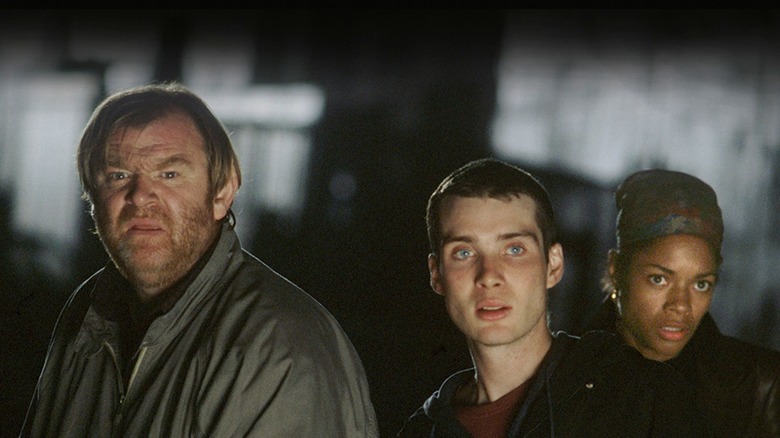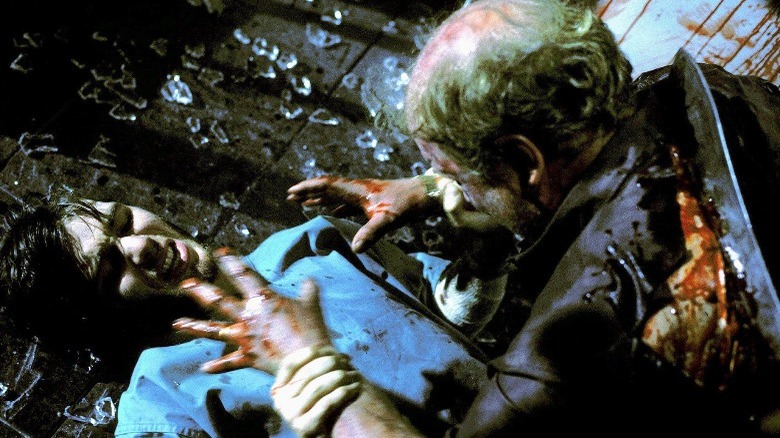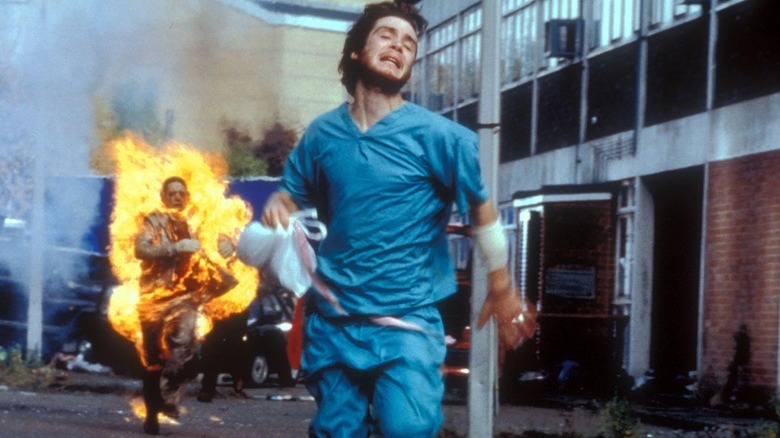Not Just Any Old Extras Would Work For 28 Days Later's Zombie Horde
In Danny Boyle's "28 Days Later," Jim (Cillian Murphy) wakes up in a hospital that seems to have been hastily abandoned. Staggering outside, he walks alone on a deserted London street and quickly realizes that there isn't a single soul to be seen on Westminster Bridge. Jim is undoubtedly wondering what happened to the world, and the answer is that a contagious, aggression-inducing virus has led to the complete disintegration of human society worldwide and turned most people into ravenous zombies. The uninfected, like Jim, are in the minority, and their survival prospects grow slimmer as time passes. To sum the situation up, one only has to refer to the graffiti in the chapel scene, which reads: "The end is extremely f***ing nigh."
The ingenuity of Boyle's "28 Days Later" is that it's not a simple zombie flick. While Jim and company need to fend off super fast, aggressive zombies to make it through, the primary threat faced by the group is monstrously human in nature. There are men who are ready to commit heinous acts to satiate their own needs, with little regard for the lives of fellow humans. There's a perpetual air of distrust and terror, as both the living and the undead are out to erase the last remnants of humanity in their own ways.
While human villainy was fairly easy to capture on the big screen, thanks to convincing, multidimensional performances, the zombie aspect of "28 Days Later" was trickier to execute. Boyle deviated from the telltale trope of zombies being dumb, slow-as-hell creatures, and the extras that ended up playing the undead needed to possess a distinct quality.
Rabid, flesh-eating zombies don't drag their feet
On the 20th anniversary of "28 Days Later" last month, Cillian Murphy and Danny Boyle spoke to NME about casting extras who could embody a new kind of zombie featured in the film. Although Boyle took inspiration from George A. Romero's "Night of the Living Dead," his zombies were more rabid, agile, and ruthless than Romero's ashen-faced shamblers. Due to the nature of their origin in "28 Days Later," the zombified creatures are closer to rabid, flesh-eating dogs who sprint toward their victims while bleeding from their eyes. To capture this sense of aggressive agility, Boyle exclusively cast athletes to play zombies in the film. He told NME:
"We wanted [the extras] to be athletes, with almost superhuman running abilities so that there was no way you could run away from them. We hired a load of ex-athletes to play a lot of the infected so that we'd have this power in them that was really quite scary."
Boyle's approach worked. Whenever the zombies grace the screen in "28 Days Later," an immediate feral energy permeates the scene as the monsters move as if fueled by maddening, irrational rage (and hunger). When the mansion is breached by zombies who are superhumanly fast and unflinchingly ferocious, for example, the stakes of the climactic sequence are immediately amped, leading viewers to genuinely worry about the fates of the central characters. We have no idea whether the officers will make it in the end, and whether the group's ammunition will be enough to take out these monumentally pissed-off, rabid creatures.
What makes 28 Days Later so scary
Over the years, Danny Boyle has spoken at length about the "incandescent murderous fury" that he wanted the infected in "28 Days Later" to embody, and how his decision to make them scarily fast emerged from a personal misunderstanding of the zombie genre. Boyle explained that rather than focusing on the element of zombies being undead, he wanted to capture the psychological repercussions of being infected by a virus that extinguished warm, humane emotions. Physical transformation aside, where the infected appear to look grotesque and murderous, there's also a base-level rewiring of the brain that wipes the proverbial slate clean. What remains is the purely animalistic instinct to hunt while giving into unfettered rage.
Boyle's zombie movie is undeniably a solid entry in the horror genre, especially because it smartly infuses political allegory into its action-heavy narrative. What makes the film truly terrifying, however, is its second half: A group of military officers, who are set up to be possible saviors of humanity, turn out to be despicable monsters who intend to assault the female survivors. Selena (Naomie Harris) and Hannah (Megan Burns), who is a child, are cruelly coerced into dressing up before the assault, highlighting the abject inhumanity of those supposed to represent order in the face of chaos. The juxtaposition between the infected, who are unwilling vehicles of terror, and the officers in the mansion, who willingly wish to participate in something so ugly, makes the final confrontation all the more jarring.
While Selena and Hannah manage to escape these men, the implications of this aspect of the story are scarier than any athletic zombie rushing toward their target.


